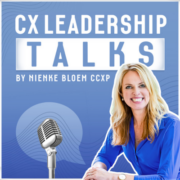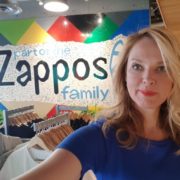The experience paradigm: Customer or Employee first?
When it comes to organizational transformation, this is an important and often raised question. What are the leading principles coming out of your strategy in order to transform your business model? Frank van den Brink, Chief Employee Experience Officer of ABN AMRO bank and I share our insights and opinions. We try to get our heads around this important leading question.
The “Why” of CEX
Nienke: Customer Experience is hip and happening. Sometimes people ask me if it is more a trend than a profession, but I can assure you; it isn’t. Since prize is not the way to stand out in the market, organizations choose customer experience to be the strategic differentiator. With many more disruptors coming into the marketplace, having no legacy of systems and culture, they are leading the way in this battlefield. They have designed their customer journeys from the perspective of their ideal customers, they have really thought of the needs and wants. Take for example Bloomon. The way they offer their Flowers is so customer focused. They meet your needs (fresh and beautiful flowers), make it easy (deliver weeknights, send a text to refresh water) and make it enjoyable (always a surprise what the bouquet looks like, but always more than beautiful). To really stand out in customer experience, it is key to make strategic choices. Because from the strategic angle, elements can be translated into processes, propositions, products, services, customer journeys and then: all elements of the HR cycle. So yes, read this article to learn about CX and EX from the professional and practitioner angle!
Frank: To get Customer Experience right, organisations should also start beginning to think about their Employee Experience in a more strategic way. For me employee experience should be the cornerstone of your HR strategy and transformation. The overall purpose should be to design and engineer a high value, integrated and relevant experience for all your employees. I strongly believe that when we are able to increase the employee experience, we will create a more engaged and productive workforce that helps the business to achieve their client goals. In the end if you truly believe that happy people = happy customers and vice versa, you should act on this leading principle and HR could perfectly lead this journey together with CX.
Experience driven companies will outperform their budgets, will realize higher customer loyalty and show better bottom line results. So yes there is a business case for investing in EX and subsequently a significant financial advantage for your organisation. If you have the opportunity to transition from a more “de” humanised, policy and process oriented and driven HR approach, towards a more consumarized HR function focusing on social platforms, technology and physical work space. Why not start tomorrow and let’s make HR great again!
How to kick start your CX/EX Transformation?
Nienke: The transformation is having a much slower pace as I would have expected to. Some companies are really taking the leap forward, but when I look at the experience of customers on review sites, we have still a very long way to go. I often use the metaphors taking the Transformational route the Steve Jobs or the Richard Branson way. Organizations that change in a Steve Jobs way, are really getting inside the customers wants and needs, learning about their feedback, organizing a structured voice of the customer and taking serious action on that. As Richard Branson says “Not customers come first, our employees come first” you understand that these companies focus much more on the Employee Experience. They enable their employees to service their customers in the best way, really hire for attitude and aim for high employee engagement.
Customer Experience Management is still maturing as a profession and the good thing is now results are proven and companies that have invested and chosen cx as a strategy are seeing the results. For example KPN, where they started with an NPS of -14 in 2012 and leading the customer experience transformation resulting in an NPS of +13 in the consumer market in 2017. What is hopeful is that Marketing is looking more at Service as opportunity, I just heard a CMO at a conference stating “Service is the new Sales” The rise of Employee Experience instead of HR is also something that I find interesting and a big leap forward.
Frank: The traditional HR function can learn a lot from the Customer Experience Paradigm. Since the Customer Experience practices and professionals have had a head start of roughly a decade or so, I see huge learning potential for traditional HR departments to join forces, make internal handshakes, share CX capabilities and focus of combined digital platforms to optimize both the customer and the employee journey. If we start seeing and treating all our valued employees as consumers and clients, then we should change the rules of the game and give them a different experience working within our company. Furthermore, since traditional organizational boundaries are becoming more fluid, I foresee opportunities to expand the Employee Experience proposition to external stakeholders as well. I truly believe this is the new way forward for organizations to remain relevant and create hybrid opportunities between EX and CX for the benefit of both clients and employees and preferably both if you really believe in your own products and would like to create future brand ambassadors.
So now, where to start?
Insights and thoughts around 6 leading questions:
- Strategy: what kind of experience would you like to deliver?
- Understanding: How do you create a consistent way of understanding?
- Experience design: How to design and improve meaningful experiences?
- Measurement and metrics: How to measure and report on experience?
- Organizational adoption: How to develop cross company accountability?
- Culture: How to create a culture of employee ambassadors?
1. Strategy: What kind of Experience would you like to deliver?
Nienke: This should the fundament of all Customer Experiences. What kind of experiences do you want your customers to have? Let me explain. Many companies do have mission and vision statements, but they often lack the customer perspective or lack a real distinction.
Questions you can ask yourself when it comes to strategy
- How do we translate our mission/vision statement to an outside in perspective?
- What is it that we as an organization, want to stand out in and why do customers have to buy our products and services ?
- What promises do we want to make to your customers? Think of brand promise or service promises?
- How do these promises translate to brand values or even employee/leadership values?
Frank: If you would like to reinvent the employee journey from scratch start with zooming out to understand your full employee journey and apply reverse thinking to redefine your HR role in this journey by:
- Deep employee research and employee needs (continuous listening) discovery through employee persona’s;
- Taking into account the entire employee and organization ecosystem;
- Identify moments that matter through your full employee journey
- Start investing in Organizational, Digital and Data capabilities in order to build, reinvent and execute employee journeys
From my experience, Employee journey design is only 20% of the work – Excellent EX delivery creates the real experience and should be on the HR agenda more often.
2. Understanding: How do you create a consistent way of understanding?
Nienke: To make it really broad, I want to think of understanding as creating an architecture of listening. To have a structured and shared understanding of customer needs and wants. Because too often organizations assume what customers want and how they perceive their interactions. This leads to interpretive design and often failing business decisions. So to overcome business blindness, a good customer understanding is necessary.
Questions to ask:
- What are the needs and wants of our customers?
- Who are our customers?
- Where do they leave their feedback? Think big, both solicited by surveys, but also unsolicited like reviews. Also ask customers that didn’t have contact or maybe even left your company as a client.
- How can we share these customer insights with our employees?
Frank: Start small and with practical used cases. Do not think too big from the start, make use of the wisdom of the crowd and include the employee perspective and input from day one. Strategy should lead to execution and execution could also go together with a new way of learning. Whether you apply agile, design thinking, lean start up methodologies is up to you, but a significant change investment in order to support the EX transformation is one of the key success factors.
3. Experience design: How to design and improve meaningful experiences?
Frank: With an analytics team gathering and analyzing insights from all functions in the business, the EX team defined “moments that matter” in employee journeys, measuring areas of high and low impact on business performance and productivity. They used design thinking to observe and ideate opportunities to build a positive EX through various journeys, which were prototyped and tested in certain parts of the business that enabled quick feedback. We came up with the following journeys and translated those to a future EX Journey Canvas:
- Best start – supporting candidate experience, recruiting, sourcing and onboarding
- Let me help you – the way we are able to support and interact with our employees
- Meaningful growth – how we enable employees to achieve a meaningful professional and personal growth through performance, learning, development
- I owe you – the way we recognize talent and performance by also focusing on wellbeing, preparation for retirement, recognizing long time contributions, a so called total reward approach
- Great ambassadors – building a strong alumni experience and long term oriented valuable networks
Nienke: The design is where actions really start. How to design your products and services from a customers perspective? There are many ways and journey mapping or service design are the most used at this moment. Both to design from scratch, but also to incrementally improve the sales or service journeys. Mapping the journey is the first step, but the next steps are about choosing where to improve and making the change happen. Benefit tracking, asking customers for feedback or using their insights in co-creating new moments of truth. It makes it easy to look at the phases of the customer journey from a meta perspective. Like the “I become a customer” and “I am a customer” perspective, or the acquisition and loyalty phase.
This is also the moment to act upon the customer insights you have gotten. So get back to customers who left their feedback on your surveys or react on reviews. Using these insights to make changes in your organization.
Questions to ask yourself:
- What methodology do we use to design from a customer’s perspective?
- What phases of the customer journey do we have?
- How to make change happen when we have mapped the journey?
- What are the top 5 irritations of our customers and what are the top 5 compliments they give us in their feedback? And how to we continuously improve upon the feedback?\
4. Measurement and metrics: How to measure and report on experience?
Nienke: Measuring and using KPI’s gives you the right steering wheel when it comes to results and decisions. You need to know where to improve and invest when it comes to customer experience. You want to know how you are performing when it comes to your customers. So choose your KPI’s wisely. The most often used KPI’s are NPS (Net Promotor Score) and CSAT (Customer Satisfaction). There is much debate about which KPI to choose. For me I suggest that you pick one and stick to it. To build your dataset, learn on the insights behind the KPI, the drivers and make sure your numbers improve. This is also where Data plays the key role. Data driven decision making, translated in the right KPI’s.
Also take a look at your reporting on these metrics and how they change over time. Tell the story why it is important. Make sure all employees know how you perform not only on EBITDA, market share but also on CX. So find a distinctive way of reporting, stay disciplined in doing it clock speed (whether it is monthly, quarterly or yearly) and make sure it is visible and people feel the sense of urgency.
Questions to ask:
- What metrics do we use when it comes to customer experience?
- Do we understand the interdependencies and know what drives great customer experiences?
- Where are these metrics discussed (steerco’s, board meetings etc) and how do we take action upon them?
- Are our reports visually attractive and tell the right story people understand?
Frank: In order to understand the needs and ambitions of our employees we need to improve our ability and willingness to listen. In the previous years we mainly listened to our employees by the use of an annual engagement survey. Where many organizations already moved away from an annual performance management approach to a more continuous dialogue between manager and employee, most organizations are still using an annual engagement survey to listen to the feedback of the employee once a year. This is slowly changing, largely due to the increasing importance of employee experience.
Having a technical ability to listen better and more continuously to our employees is one thing, using it on a daily or weekly basis is another. Basically it is about understanding and threating your employees as you treat your customer. HR should position itself more as the employee marketer. We need to better understand the different groups of employees, their needs and the opportunities to increase their employee experience and their performance. This requires a different mindset. A mindset that is built on curiosity to understand our employee’s needs, the ability to identify and act on employee leads, the ability to work with tools and data and the ability to turn the employee feedback into usage. Basically a willingness to understand and learn.
At the moment we are in the middle of defining our Employee Experience Index / Employee Net Promotor Score (eNPS) supported by continuous listening tooling, with a clear focus on creating the right employee data, putting in place the right technical capabilities and data quality & governance. If you would like to know more about this topic, please read my article together with Patrick Coolen on “How HR is hitting the second wall”.
5. Organisational Adoption: How to develop cross company accountability?
Nienke: The question I often get is, how is customer experience organized? That is a fascinating question, because I see many different ways of how it is organized and placed. It could be as a staff team, one tier below the CEO. Or as a team in marketing, where the focus is often with a Sales lens. There is not one good or bad way of organizing, as long as the scope and budget are aligned. To have real impact, it is of importance, utmost importance, that it is in tier minus one or two and belief of the C-Suite. When looking at the impact of Customer Experience and the size of the teams, it is interesting to see the ways they find to influence. In agile organizations customer experience is often introduced in epics or story points. Also leading principles find their way into the CX domain. Interesting developments where methodologies align. We also see steering committees where the most important customer decisions are taken or veto rights for the VP customer experience, maybe a little old fashioned, but it works.
Questions to ask:
- How to make sure customers and their needs/wants are embedded in our change process?
- Who is responsible for the KPI’s we have defined for customer experience?
- Where in our organization is Customer Experience organized?
- Is the budget in fte and money, aligned with the scope of the CX team?
Frank: My biggest challenge of today is: How to offer our employees a great employee experience in a purpose-led and value-driven organization. In order use this as a leading principle and shape our future of work we need a definition of happiness…. whereas I pretty much fancy the definition on happiness = (equals) reality – expectations.
When an employee experiences a WOW, you are giving them a pleasant surprise. You are exceeding their expectations. You are addressing their needs thoughtfully and in unexpected ways. It is an expression of your authentic interest in the person who needs your services, not just in the transaction. It is about making enduring personal emotional connections with empathy, generosity, and gratitude. It is about awareness of common human concerns that make a difference to each customer. It is about truth, it is about meaning, it is about details that cannot only be measured by KPIs.
In today’s ultra-competitive markets, enduring businesses call for enduring employee relationships and relations. How can you deliver products and services with a WOW Employee Experience built into them? You must make the WOW Employee Experience part of the product/service design, and that requires a continuous culture and happiness decision-making context, not only once for purposes of definition, but as a foundation for day to day operations and mind set of HR colleagues.
I defined “wow” experiences as “unique, emotionally engaging interactions that go beyond expectations and are readily recounted.”
Key elements of What is WOW
- A pleasant surprise, thoughtfully and in unexpected ways.
- Addressing their needs: basic product and service needs, transactional needs and emotional needs
- Personal emotional connections awareness of common human concerns
- It is about truth and meaning
- It is about details that cannot be measured by KPIs.
6. Culture: How to create a culture of employee ambassadors?
Do all of the above and employees will value the employee journey and experiences more than ever!!!
Culture eats strategy for breakfast, as Peter Drucker said. This is the same with customer experience. The employees deliver the customer experiences in the offline world and they are the ones who design and execute all inside the company and in the digital environment. To impact, I suggest this is where Employee Experience (HR) and CX colleagues should team up. To hire the right employees, onboard them with real customer focus and make sure the customer is present in the training and development calendar.
Where to start when it comes to culture. Make sure you have your customer promises (compass, manifesto) and translate them to the values of your company. So everybody know what they have to live up to, what to and also what not to do. This is of course not only for employees, but even more evident for the leadership. Make sure they interact with customers and customer facing employees in a regular manner. Nienke: I just talked to a CFO of a B2B company and he admitted he had never spoken face to face with a customer in the 16 years he worked for the company.
Reward and celebrate target behaviour and make the customer visible in the business. Whether it is in the boardroom in reports or in the canteen where photo’s and quotes are place on the wall. This where it comes to finding creative ways that work. That make customer experience come to life and cultures grow into customer centric ones.
The experience paradigm: Our conclusion?!
In the end it is a mirror. Happy people equals Happy Customers and vice versa Happy Clients equals Happy Employees. Both start from the same strategic perspective, the same methodologies but with a different audience.
Yes CX is ahead. So EX professionals contact your CX colleagues in your organizations to learn the tools and tricks and join hands to get a serious position on the strategic agenda. For CX professionals join hands with your HR or EX professionals, because they can be the leverage to stand out when it comes to the employee side of the experience. This is where all human interactions take place. We are very interested in your thoughts and insights on this paradigm. We invite you to share these with us! Share your thoughts and stories on this paradigm with us.
About some valuable sources:
During the last year we are inspired by many highly appreciated thought leaders whom we spoke to, worked with or followed on social media and blogs on the topic of Customer Experience and Employee Experience. Again with the risk of leaving out relevant influencers, in which case we apologize, we like to mention the following people; Bruce Temkin CCXP , Jaap Wilms CCXP, Blake Morgan, Ian Golding CCXP, Jeanne Bliss CCXP, Kathy van der Laar CCXP, Barbara van Duin CCXP, Eric Vercouteren (KPN), Jacob Morgan, Mark Levy, David Green, Elliot Nelson (KennedyFitch), Sanne Welzen (Deloitte), Roy Klaassen (Kirkman Company).
*****
Nienke Bloem is often called the Customer Experience speaker in the blue dress.
She’s a global CX thought leader, educator and a global keynote speaker who inspires audiences with best practices and proven methodologies. She leads a speaking practice, a CX game company and a training business; she breathes Customer Experiences and is author of two CX books.
Her two-day Customer Experience Masterclass is known as the best program to prepare for your CCXP and she is the go-to person voor CX leaders who want to advance their leadership and bring direct results from their Customer Experience transformation programs. Since 2020, she hosts a CX Leadership Masterminds program and helps leaders spice up their leadership and deliver an engaging CX Story including a solid CX Strategy. Besides, she is a modern-day pilgrim and found the parallel with leading customer centric transformations.
With her over 20 years corporate experience, she speaks the business language. Her keynotes and education programs in Customer Experience are inspiring and hands-on. She is one of the few Recognized Training Partners of the CXPA and it is her mission to Make Customer Experience Work and help you deliver business results.
Subscribe to my weekly newsletter to stay inspired!









